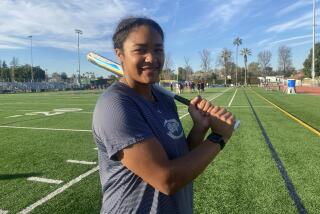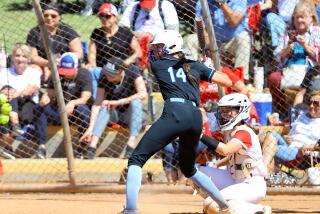Diamond Can Be Girls’ Best Friend : On the fields of Orange County and the nation, fast-pitch softball has become the domain of girls--thousands of athletes who mean business. And on the sidelines are not just proud parents but also professional coaches and college scouts.
- Share via
Another Saturday morning, and 11-year-old Laura Miklos, her blond hair tied atop her head, is standing in a Tustin schoolyard looking like a Norman Rockwell cover.
But then she starts to move, and the cuteness dissolves. Staring ahead intensely, she leans forward and down, almost into a crouch. As she starts to step forward and uncoil, she cocks her right arm backward slightly, then windmills it forward. It accelerates up, over, behind, then forward again, whipping a seven-ounce, leather-covered warhead toward the girl standing 37 feet away.
The softball, traveling a good 45 m.p.h., rises over the swinging bat, above the catcher’s mitt and hits the backstop planks with a tremendous whack. This is not cute. This is strike two.
This is girls’ softball in Tustin--and for that matter, in Irvine, Lake Forest, Mission Viejo, Huntington Beach, Yorba Linda, Brea and hundreds of other cities in Southern California and the nation.
Fast-pitch softball, once the pastime of strong-armed factory workers and their sons, has by and large been abandoned to the girls. “The men are playing slow-pitch now because there are so few pitchers, and the boys are playing baseball,” says Bill Redmer, editor of FastPitchWorld magazine.
And the girls are playing it for real. Backed by parents willing to hire professional coaches and travel to distant tournaments, enticed by full-ride athletic scholarships from major universities, girls are playing softball the way boys have played baseball, basketball and football: all-out, with an eye to the future.
“When girls were given the right to equal opportunities in sports (with the 1972 passage of Title IX, a federal law forbidding sex discrimination in education programs), fast-pitch softball was one of the sports that really took off,” Redmer says. “Softball is probably the most prominent example of where women have made dramatic gain.” The National Federation of State High School Assns. estimated two years ago there were 270,000 girls playing on high-school teams nationwide, he says.
The chain that has existed for so long in boys’ sports now has formed around girls’ softball. High school coaches scout the youth leagues. Colleges scout the high schools.
“When we go to tournaments now in Southern California, it’s not unusual to have scouts from 80 different colleges there,” says Judi Garman, the Hall-of-Fame coach of the traditionally powerful Cal State Fullerton women’s softball team. “We could have a coach’s convention at every tournament.”
They come, Garman says, “because the good ball players are in Southern California.” They’re good, she says, because the serious ones have been well coached and have played 120 games or so a year, all year, in leagues, in tournaments and on tour, since they were in elementary school. “By the time we get them, they’re really seasoned ballplayers.”
*
They start as young as 5. The Amateur Softball Assn. of America, national governing body of the sport, claims to have 2,000 girls teams in Orange County alone. Independent leagues may have more. One of the largest, Bobby Sox Softball, was formed in Buena Park in 1963 and now has an estimated 40,000 players in Hawaii, California, Arizona, Nevada, Utah and Colorado.
The talented ones, and the ones with enthusiastic and well-heeled parents, soon turn to professional coaches. “There are literally hundreds of guys in Southern California alone,” Redmer says.
Guys like Richard Hickey of Irvine. On this particular Friday he was seated inside a long net enclosure at a Laguna Hills shopping center watching Laura Miklos whirl the softball toward a white canvas rectangle 43 feet away. Every hit represented a strike. “She throws way more strikes than balls,” Hickey says.
Hickey’s advice costs $25 per half hour. That and hitting lessons for Laura and her 13-year-old sister Jenny cost her parents $65 a week. That’s about the limit right now, says her CPA father, Steve Miklos. Nine-year-old Kimmy, who also plays Bobby Sox, will have to wait for lessons.
Hickey has been coaching Laura for three years, and “I definitely know she has it,” he says. “I’m working 15 to 20 lessons a day, five days a week, and you pretty much know when you’ve got a hot prospect. With the family backing and with her desire and drive, there’s not much that can stop her. Especially when she has Big Sister to motivate her.”
Big Sister’s motivation takes the form of standing at the plate during pitching practice and whacking any pitch that comes in a little too fat. Big Sister can hit, “and when Laura pitches to her, she knows she’s got to be on or she gets the ball back real fast.”
Laura can deliver a drop ball, a change-up and a 45-m.p.h. fastball, and she’s begun working on softball’s supreme pitch, the riser. That’s good for her age, but she will have to improve considerably, Hickey says.
“Fifteen years ago, we had primarily male students, but then the girls’ scholarships came in. At that time a high-school pitcher throwing 55 m.p.h. could go to any university if her grades were up. We had girls throwing 50 or 52 and getting full rides in Oregon and New Mexico. Now we have 12- and 15-year-olds throwing better than that.”
*
Just how good the girls can become was demonstrated in the mid 1980s in Placentia. Michele Granger, tall and long-limbed, pitched 36 no-hitters for Valencia High School with a fastball that eventually reached 70 m.p.h. during her adult years at UC Berkeley. At that speed, the ball arrives at the plate in 0.42 of a second. (A 90-m.p.h. major-league fastball arrives in 0.46 of a second.)
Now married and living in Alaska, Granger is a hot prospect for the U.S. team in 1996, when women’s softball becomes a full-fledged Olympic sport.
“She brought a lot of interest to the game,” says Don Sarno of Brea, her longtime pitching tutor and himself a Hall of Fame pitcher. He is pitching coach for the U.S. team in next month’s world championships.
“She was in the papers and People magazine a lot. She drew big crowds. Kids see that and want to be like that.”
Such players were bound to emerge once the little-girl leagues took root, Sarno says. “The game was played primarily by adult women in the ‘60s. The Lionettes in Orange (first an amateur team, then professional) was probably one of the greatest teams ever assembled. The girls’ teams started growing in the ‘70s and really took off in the ‘80s.
*
That is when the Miklos family joined up, and it has become a way of life. Call them when they’re not home and the answering machine answers, “Strike one, strike two, strike three, we’re out!”
Steve Miklos, a college baseball player until he quit to concentrate on his studies, is president of Tustin Bobby Sox and coaches Laura’s team. Wife Janet Miklos, who played baseball with her brothers and disliked the tamer girl’s sports of her high-school days, manages Jenny’s team. All three daughters play. Laura and Kimmy are on the same team this year to reduced the time three separate practice and game schedules require.
Miklos, the ex-jock, says he couldn’t be happier. “People would say, ‘Poor Steve, he doesn’t have any sons.’ That’s a laugh,” says Janet Miklos. Those days are virtually dead, she says.
“The biggest change in girls’ sport is that it’s now accepted by boys,” says Redmer. “They expect the girls to be athletic.”
“I think boys recognize the girls as equal athletes--a lot of them, anyway,” Hickey says. “You don’t see a lot of difference between a boy and girl at 11 years old. It’s really amazing. You put the two up together, they could play on the same team. A lot of dads won’t agree with you if they have sons, but it’s true.”
Attitudes that girls must be protected from hard physical competition still persist, in the South especially, Redmer says. For years there, girls have been allowed to play only slow-pitch softball, in which pitches are lofted toward the plate rather than thrown hard and fast.
Late last year, parents viewing fast-pitch softball as a road to a free college degree demanded that high schools provide fast-pitch teams for their daughters, and the Kentucky legislature passed an enabling law. Florida had passed similar legislation.
“There are still a lot of people afraid to see little girls run and jump and slide and be athletically active,” Redmer says. “As soon as these dinosaurs fade away, girls will have the opportunity to succeed and fail.”
*
Those days are long gone in Southern California, Garman says. Back in 1971 she was hired to coach at Golden West College in Huntington Beach because the athletic director “was frustrated at the lack of opportunity for his daughter. He saw boys in uniforms and on good fields and saw the girls playing on park fields with throw-down bases being told ‘just go play.’ ” Today’s girls’ leagues and tournaments with able coaches and good facilities “has been a long time coming,” she says.
Thirty years ago, many doubted that women’s professional tennis would command the attention it does today. Will the same thing happen to women’s softball?
“We all cross our fingers and hope,” says Garman, “because it’s frustrating to see the great players, who if they were just a different sex, would be pulling in millions of dollars.”
Special Deliveries: Tale of Two Tosses
The basic difference in pitching style between fast-pitch softball and baseball is the overhand-versus-underhand delivery. Both types of balls can be thrown at more than 100 m.p.h. Shown is the process for right-handers; reverse if you’re left-handed)
Fast-Pitch Softball 1. Raise right hand over head, bend left knee 2. Swinging right arm from overhead to behind back, shift weight to right side 3. Using pitcher’s plate for leverage, push weight back to left side 4. Thrust pitching arm forward; release ball 5. Follow through with right arm high on right side.
Baseball 1. Lean backward and transfer weight onto left side while raising both hands 2. Shifting weight to right side, lower arms and curl left knee to chest 3. Cock right arm and, using pitching rubber for leverage, push weight to left side 4. Snap right arm forward; release ball 5. Follow through across body to left side
Notebook * More than 2.5 million girls play fast-pitch softball nationwide. * In Orange County, about 3,000 high school girls play fast-pitch softball each year. * Average speed fast-pitch for high school starting pitcher: 53 m.p.h.
Softball Material: Cork core with layer of fiber matting covered with cowhide Circumference: 12 inches Weight: Six to seven ounces
Baseball Material: Layers of cork, rubber and woolen yarn covered with cowhide Circumference: Nine inches Weight: Five ounces
Sources: Rancho Santiago College, World Book Encyclopedia, Fast-pitch World Magazine
Researched by APRIL JACKSON / Los Angeles Times
More to Read
Get our high school sports newsletter
Prep Rally is devoted to the SoCal high school sports experience, bringing you scores, stories and a behind-the-scenes look at what makes prep sports so popular.
You may occasionally receive promotional content from the Los Angeles Times.






